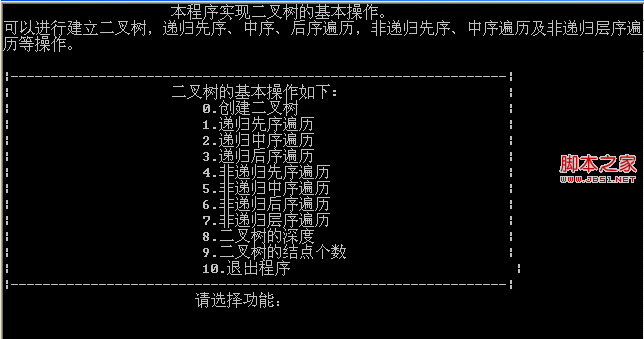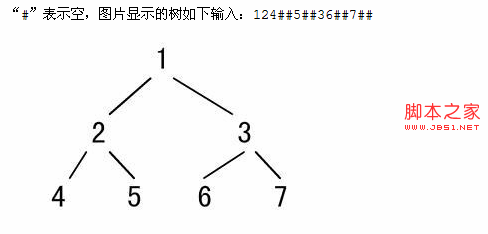先使用先序的方法建立一棵二叉樹,然後分別使用遞歸與非遞歸的方法實現前序、中序、後序遍歷二叉樹,並使用了兩種方法來進行層次遍歷二叉樹,一種方法就是使用STL中的queue,另外一種方法就是定義了一個數組隊列,分別使用了front和rear兩個數組的下標來表示入隊與出隊,還有兩個操作就是求二叉樹的深度、結點數。。。
代碼如下:
#include<iostream>
#include<queue>
#include<stack>
using namespace std;
//二叉樹結點的描述
typedef struct BiTNode
{
char data;
struct BiTNode *lchild, *rchild; //左右孩子
}BiTNode,*BiTree;
//按先序遍歷創建二叉樹
//BiTree *CreateBiTree() //返回結點指針類型
//void CreateBiTree(BiTree &root) //引用類型的參數
void CreateBiTree(BiTNode **root) //二級指針作為函數參數
{
char ch; //要插入的數據
scanf("\n%c", &ch);
//cin>>ch;
if(ch=='#')
*root = NULL;
else
{
*root = (BiTNode *)malloc(sizeof(BiTNode));
(*root)->data = ch;
printf("請輸入%c的左孩子:",ch);
CreateBiTree(&((*root)->lchild));
printf("請輸入%c的右孩子:",ch);
CreateBiTree(&((*root)->rchild));
}
}
//前序遍歷的算法程序
void PreOrder(BiTNode *root)
{
if(root==NULL)
return ;
printf("%c ", root->data); //輸出數據
PreOrder(root->lchild); //遞歸調用,前序遍歷左子樹
PreOrder(root->rchild); //遞歸調用,前序遍歷右子樹
}
//中序遍歷的算法程序
void InOrder(BiTNode *root)
{
if(root==NULL)
return ;
InOrder(root->lchild); //遞歸調用,前序遍歷左子樹
printf("%c ", root->data); //輸出數據
InOrder(root->rchild); //遞歸調用,前序遍歷右子樹
}
//後序遍歷的算法程序
void PostOrder(BiTNode *root)
{
if(root==NULL)
return ;
PostOrder(root->lchild); //遞歸調用,前序遍歷左子樹
PostOrder(root->rchild); //遞歸調用,前序遍歷右子樹
printf("%c ", root->data); //輸出數據
}
/*
二叉樹的非遞歸前序遍歷,前序遍歷思想:先讓根進棧,只要棧不為空,就可以做彈出操作,
每次彈出一個結點,記得把它的左右結點都進棧,記得右子樹先進棧,這樣可以保證右子樹在棧中總處於左子樹的下面。
*/
void PreOrder_Nonrecursive2(BiTree T) //先序遍歷的非遞歸
{
if(!T)
return ;
stack<BiTree> s;
s.push(T);
while(!s.empty())
{
BiTree temp = s.top();
cout<<temp->data<<" ";
s.pop();
if(temp->rchild)
s.push(temp->rchild);
if(temp->lchild)
s.push(temp->lchild);
}
}
void PreOrder_Nonrecursive(BiTree T) //先序遍歷的非遞歸
{
if(!T)
return ;
stack<BiTree> s;
while(T) // 左子樹上的節點全部壓入到棧中
{
s.push(T);
cout<<T->data<<" ";
T = T->lchild;
}
while(!s.empty())
{
BiTree temp = s.top()->rchild; // 棧頂元素的右子樹
s.pop(); // 彈出棧頂元素
while(temp) // 棧頂元素存在右子樹,則對右子樹同樣遍歷到最下方
{
cout<<temp->data<<" ";
s.push(temp);
temp = temp->lchild;
}
}
}
void InOrderTraverse(BiTree T) // 中序遍歷的非遞歸
{
if(!T)
return ;
stack<BiTree> S;
BiTree curr = T->lchild; // 指向當前要檢查的節點
S.push(T);
while(curr != NULL || !S.empty())
{
while(curr != NULL) // 一直向左走
{
S.push(curr);
curr = curr->lchild;
}
curr = S.top();
S.pop();
cout<<curr->data<<" ";
curr = curr->rchild;
}
}
void PostOrder_Nonrecursive(BiTree T) // 後序遍歷的非遞歸
{
stack<BiTree> S;
BiTree curr = T ; // 指向當前要檢查的節點
BiTree previsited = NULL; // 指向前一個被訪問的節點
while(curr != NULL || !S.empty()) // 棧空時結束
{
while(curr != NULL) // 一直向左走直到為空
{
S.push(curr);
curr = curr->lchild;
}
curr = S.top();
// 當前節點的右孩子如果為空或者已經被訪問,則訪問當前節點
if(curr->rchild == NULL || curr->rchild == previsited)
{
cout<<curr->data<<" ";
previsited = curr;
S.pop();
curr = NULL;
}
else
curr = curr->rchild; // 否則訪問右孩子
}
}
void PostOrder_Nonrecursive(BiTree T) // 後序遍歷的非遞歸 雙棧法
{
stack<BiTree> s1 , s2;
BiTree curr ; // 指向當前要檢查的節點
s1.push(T);
while(!s1.empty()) // 棧空時結束
{
curr = s1.top();
s1.pop();
s2.push(curr);
if(curr->lchild)
s1.push(curr->lchild);
if(curr->rchild)
s1.push(curr->rchild);
}
while(!s2.empty())
{
printf("%c ", s2.top()->data);
s2.pop();
}
}
int visit(BiTree T)
{
if(T)
{
printf("%c ",T->data);
return 1;
}
else
return 0;
}
void LeverTraverse(BiTree T) //方法一、非遞歸層次遍歷二叉樹
{
queue <BiTree> Q;
BiTree p;
p = T;
if(visit(p)==1)
Q.push(p);
while(!Q.empty())
{
p = Q.front();
Q.pop();
if(visit(p->lchild) == 1)
Q.push(p->lchild);
if(visit(p->rchild) == 1)
Q.push(p->rchild);
}
}
void LevelOrder(BiTree BT) //方法二、非遞歸層次遍歷二叉樹
{
BiTNode *queue[10];//定義隊列有十個空間
if (BT==NULL)
return;
int front,rear;
front=rear=0;
queue[rear++]=BT;
while(front!=rear)//如果隊尾指針不等於對頭指針時
{
cout<<queue[front]->data<<" "; //輸出遍歷結果
if(queue[front]->lchild!=NULL) //將隊首結點的左孩子指針入隊列
{
queue[rear]=queue[front]->lchild;
rear++; //隊尾指針後移一位
}
if(queue[front]->rchild!=NULL)
{
queue[rear]=queue[front]->rchild; //將隊首結點的右孩子指針入隊列
rear++; //隊尾指針後移一位
}
front++; //對頭指針後移一位
}
}
int depth(BiTNode *T) //樹的深度
{
if(!T)
return 0;
int d1,d2;
d1=depth(T->lchild);
d2=depth(T->rchild);
return (d1>d2?d1:d2)+1;
//return (depth(T->lchild)>depth(T->rchild)?depth(T->lchild):depth(T->rchild))+1;
}
int CountNode(BiTNode *T)
{
if(T == NULL)
return 0;
return 1+CountNode(T->lchild)+CountNode(T->rchild);
}
int main(void)
{
BiTNode *root=NULL; //定義一個根結點
int flag=1,k;
printf(" 本程序實現二叉樹的基本操作。\n");
printf("可以進行建立二叉樹,遞歸先序、中序、後序遍歷,非遞歸先序、中序遍歷及非遞歸層序遍歷等操作。\n");
while(flag)
{
printf("\n");
printf("|--------------------------------------------------------------|\n");
printf("| 二叉樹的基本操作如下: |\n");
printf("| 0.創建二叉樹 |\n");
printf("| 1.遞歸先序遍歷 |\n");
printf("| 2.遞歸中序遍歷 |\n");
printf("| 3.遞歸後序遍歷 |\n");
printf("| 4.非遞歸先序遍歷 |\n");
printf("| 5.非遞歸中序遍歷 |\n");
printf("| 6.非遞歸後序遍歷 |\n");
printf("| 7.非遞歸層序遍歷 |\n");
printf("| 8.二叉樹的深度 |\n");
printf("| 9.二叉樹的結點個數 |\n");
printf("| 10.退出程序 |\n");
printf("|--------------------------------------------------------------|\n");
printf(" 請選擇功能:");
scanf("%d",&k);
switch(k)
{
case 0:
printf("請建立二叉樹並輸入二叉樹的根節點:");
CreateBiTree(&root);
break;
case 1:
if(root)
{
printf("遞歸先序遍歷二叉樹的結果為:");
PreOrder(root);
printf("\n");
}
else
printf(" 二叉樹為空!\n");
break;
case 2:
if(root)
{
printf("遞歸中序遍歷二叉樹的結果為:");
InOrder(root);
printf("\n");
}
else
printf(" 二叉樹為空!\n");
break;
case 3:
if(root)
{
printf("遞歸後序遍歷二叉樹的結果為:");
PostOrder(root);
printf("\n");
}
else
printf(" 二叉樹為空!\n");
break;
case 4:
if(root)
{
printf("非遞歸先序遍歷二叉樹:");
PreOrder_Nonrecursive(root);
printf("\n");
}
else
printf(" 二叉樹為空!\n");
break;
case 5:
if(root)
{
printf("非遞歸中序遍歷二叉樹:");
InOrderTraverse(root);
printf("\n");
}
else
printf(" 二叉樹為空!\n");
break;
case 6:
if(root)
{
printf("非遞歸後序遍歷二叉樹:");
PostOrder_Nonrecursive(root);
printf("\n");
}
else
printf(" 二叉樹為空!\n");
break;
case 7:
if(root)
{
printf("非遞歸層序遍歷二叉樹:");
//LeverTraverse(root);
LevelOrder(root);
printf("\n");
}
else
printf(" 二叉樹為空!\n");
break;
case 8:
if(root)
printf("這棵二叉樹的深度為:%d\n",depth(root));
else
printf(" 二叉樹為空!\n");
break;
case 9:
if(root)
printf("這棵二叉樹的結點個數為:%d\n",CountNode(root));
else
printf(" 二叉樹為空!\n");
break;
default:
flag=0;
printf("程序運行結束,按任意鍵退出!\n");
}
}
system("pause");
return 0;
}
運行效果圖如下:

分別輸入:
1
2
4
#
#
5
#
#
3
6
#
#
7
#
#
就可以構造如下圖所示的二叉樹了。。

後序遍歷非遞歸的另外一種寫法:
代碼如下:
/*
後序遍歷由於遍歷父節點是在遍歷子節點之後,而且左節點和右節點遍歷後的行為不一樣,
所以需要用變量來記錄前一次訪問的節點,根據前一次節點和現在的節點的關系來確定具體執行什麼操作
*/
void Postorder(BiTree T)
{
if(T == NULL)
return ;
stack<BiTree> s;
BiTree prev = NULL , curr = NULL;
s.push(T);
while(!s.empty())
{
curr = s.top();
if(prev == NULL || prev->lchild == curr || prev->rchild == curr)
{
if(curr->lchild != NULL)
s.push(curr->lchild);
else if(curr->rchild != NULL)
s.push(curr->rchild);
}
else if(curr->lchild == prev)
{
if(curr->rchild != NULL)
s.push(curr->rchild);
}
else
{
cout<<curr->data;
s.pop();
}
prev = curr;
}
}
輸入二叉樹中的兩個節點,輸出這兩個結點在數中最低的共同父節點。
思路:遍歷二叉樹,找到一條從根節點開始到目的節點的路徑,然後在兩條路徑上查找共同的父節點。
代碼如下:
// 得到一條從根節點開始到目的節點的路徑
bool GetNodePath(TreeNode *pRoot , TreeNode *pNode , vector<TreeNode *> &path)
{
if(pRoot == NULL)
return false;
if(pRoot == pNode)
return true;
else if(GetNodePath(pRoot->lchild , pNode , path) )
{
path.push_back(pRoot->lchild);
return true;
}
else if(GetNodePath(pRoot->rchild , pNode , path) )
{
path.push_back(pRoot->rchild);
return true;
}
return false;
}
TreeNode *GetLastCommonNode(const vector<TreeNode *> &path1 , const vector<TreeNode *> &path2)
{
vector<TreeNode *>::const_iterator iter1 = path1.begin();
vector<TreeNode *>::const_iterator iter2 = path2.begin();
TreeNode *pLast;
while(iter1 != path1.end() && iter2 != path2.end() )
{
if(*iter1 == *iter2)
pLast = *iter1;
else
break;
iter1++;
iter2++;
}
return pLast;
}
TreeNode *GetLastCommonParent(TreeNode *pRoot , TreeNode *pNode1 , TreeNode *pNode2)
{
if(pRoot == NULL || pNode1 == NULL || pNode2 == NULL)
return NULL;
vector<TreeNode *> path1;
GetNodePath(pRoot , pNode1 , path1);
vector<TreeNode *> path2;
GetNodePath(pRoot , pNode2 , path2);
return GetLastCommonNode(path1 , path2);
}

